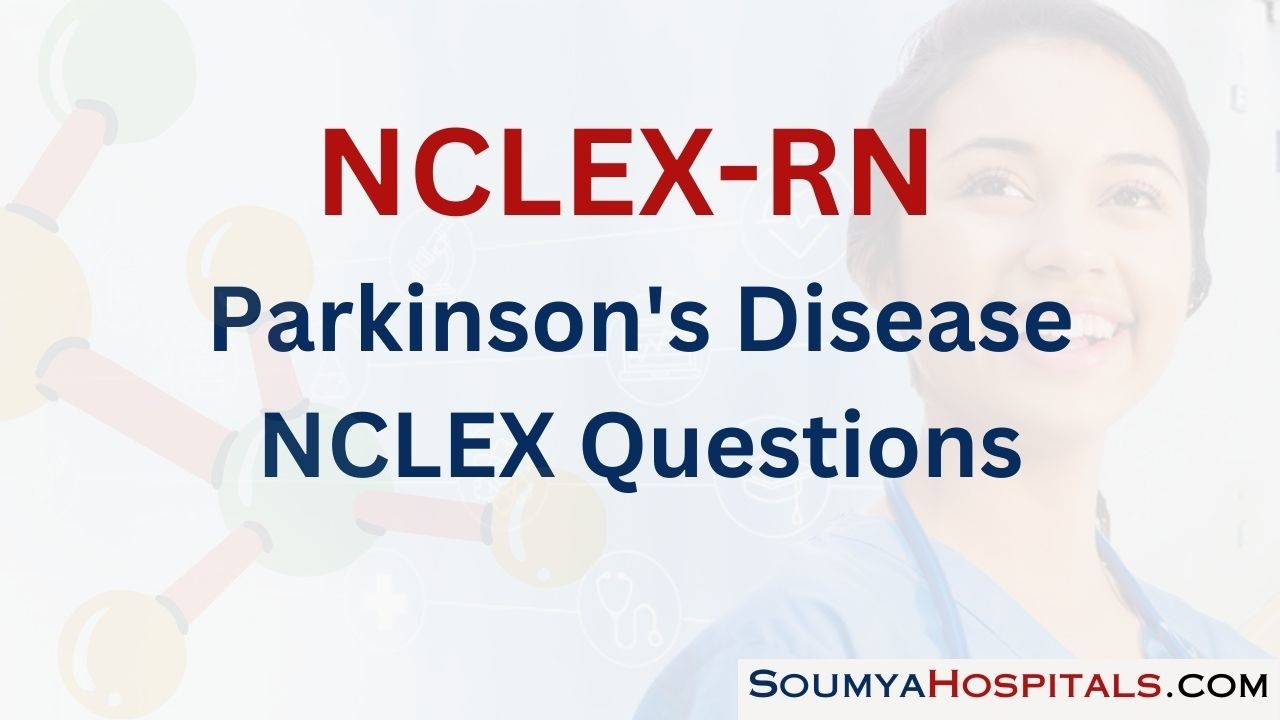Some NCLEX RN Practice Questions require students to apply their knowledge of nursing laws, regulations, and professional ethics.
NCLEX Parkinson's Disease Questions - NCLEX Questions on Parkinson's Disease
Parkinson's Disease NCLEX Practice Questions
Question 1.
Mrs. Agrima is a 78-year-old woman who has been diagnosed with Parkinson's disease. She has been experiencing slow and sluggish movement, tremors in her hands and fingers, and monotonous speech without facial expression. Mrs. Agrima has also been struggling with constipation and maintaining her nutritional status.
What are some nursing interventions for patients with Parkinson's disease?
(a) Promote slow walking and maintain physical coordination and posture through physical therapy
(b) Encourage independence in performing ADLs and achieve optimal bowel elimination
(c) Attain and maintain acceptable nutritional status and achieve effective communication
(d) All of the above
Answer:
(d) All of the above
Explanation:
The nursing interventions for patients with Parkinson's disease are directed towards maintaining the physical coordination, posture, and rehabilitative approach with physical therapy. These interventions aim to promote independence in performing ADLs, achieve optimal bowel elimination, attain and maintain acceptable nutritional status, achieve effective communication, and develop positive coping mechanisms. All of these interventions are important for the overall well-being of patients with Parkinson's disease and can help improve their quality of life.
Rationale:
Option (a) is correct because promoting slow walking and maintaining physical coordination and posture through physical therapy can help improve the mobility and function of patients with Parkinson's disease. Option (b) is correct because encouraging independence in performing ADLs and achieving optimal bowel elimination can help improve the quality of life of patients with Parkinson's disease.
Option (c) is correct because attaining and maintaining acceptable nutritional status and achieving effective communication are important for the overall well-being of patients with Parkinson's disease. Therefore, option (d) is the correct answer.

Question 2.
Mrs. Agrima is a 67-year-old woman who has been diagnosed with Parkinson's disease. She has been experiencing slow and sluggish movements, tremors in her hands and fingers, and monotonous speech without facial expression. Mrs. Agrima has also had difficulty maintaining her balance while standing and walking, and has had problems with constipation due to her sedentary lifestyle.
Which of the following nursing interventions would be most appropriate for a patient with Parkinson's disease who is experiencing slow and sluggish movements, tremors in the hands and fingers, and monotonous speech without facial expression?
(a) Encourage the patient to walk slowly and rock back and forth to initiate movement
(b) Assist the patient with tasks that they are unable to perform independently
(c) Encourage the patient to take at least 2 liters of water per day and provide them with high protein and high fiber meals
(d) Elelp the patient develop positive coping mechanisms.
Answer:
(a) Encourage the patient to walk slowly and rock back and forth to initiate movement
(b) Assist the patient with tasks that they are unable to perform independently
(c) Encourage the patient to take at least 2 liters of water per day and provide them with high protein and high fiber meals
(d) Elelp the patient develop positive coping mechanisms.
Explanation:
All of the options listed in the question are correct answers because they are all mentioned in the case study as nursing interventions for a patient with Parkinson's disease. Encouraging the patient to walk slowly and rock back and forth to initiate movement, assisting the patient with tasks they are unable to perform independently, encouraging the patient to take at least 2 liters of water per day and provide them with high protein and high fiber meals, and helping the patient develop positive coping mechanisms are all interventions that can help the stroke.
Rationale:
Option (a) Encourage the patient to walk slowly and rock back and forth to initiate movement is a correct answer because this intervention is mentioned in the case study as a way to help the patient maintain their physical coordination and posture.
Option (b) Assist the patient with tasks that they are unable to perform independently is a correct answer because this intervention is mentioned in the case study as a way to help the patient maintain their independence in performing ADLs.
Option (c) Encourage the patient to take at least 2 liters of water per day and provide them with high protein and high fiber meals is a correct answer because this intervention is mentioned in the case study as a way to help the patient achieve acceptable nutritional status and prevent constipation.
Option (d) Help the patient develop positive coping mechanisms is a correct answer because this intervention is mentioned in the case study as a way to help the patient manage the challenges of living with Parkinson's disease.
Read More:
